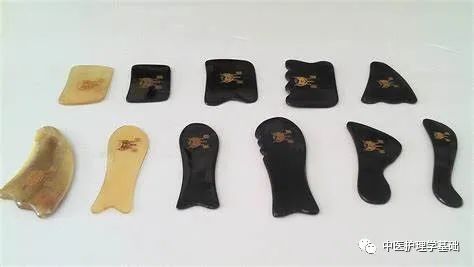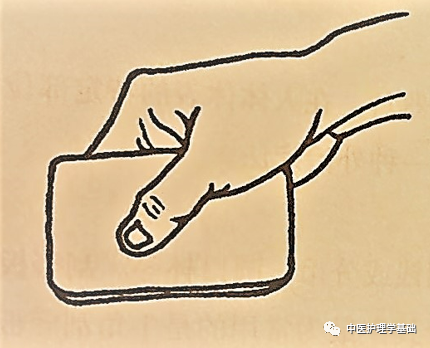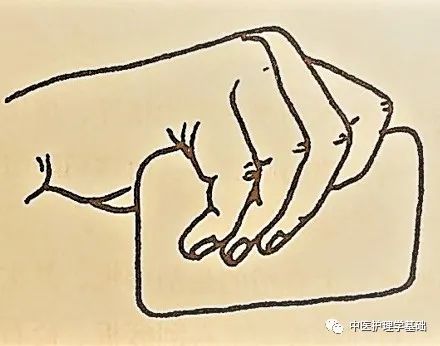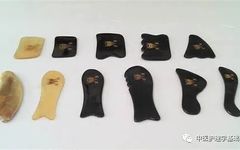Gua Sha is one of the representative clinical techniques of acupuncture in Traditional Chinese Medicine (TCM). In ancient times, it served as a primitive, simple, and direct method of surface stimulation therapy, playing an important role in safeguarding the health of the populace. The Gua Sha method is guided by the theories of TCM, utilizing blunt-edged tools to perform systematic scraping on specific areas of the body surface, thereby achieving the purpose of disease prevention and treatment. Due to its simplicity, convenience, low cost, and effectiveness, it is widely applied and suitable for both medical and home healthcare. So how much do you know about Gua Sha?
1. Historical Origins
The Gua Sha therapy originated in the Paleolithic era, when people instinctively rubbed or pounded certain areas of their body with their hands or stone pieces when ill, sometimes alleviating their ailments. Through long-term practice and accumulation, the method of using Bian stone for healing gradually formed, which is the prototype of the “Gua Sha” therapy.
With the development of medicine, modern Gua Sha therapy has been continuously improved. For instance, refined water buffalo horn scraping boards have replaced the old tools like coins and porcelain pieces, and Gua Sha has been further integrated with TCM theories, expanding its range of applications. It not only treats conditions such as fever and surface pain but also has certain therapeutic effects on some internal organ diseases through the principle of treating internal diseases externally.
2. Basic Knowledge of Gua Sha
1. Gua Sha Tools
The main tool used for Gua Sha is the scraping board, followed by porcelain spoons, coins, or round cups. Depending on the material, Gua Sha boards can be made of water buffalo horn, jade, or Bian stone, with the water buffalo horn board being the most commonly used. Gua Sha boards come in various shapes, including fish-shaped, rectangular, triangular, and comb-shaped. Typically, the scraping board consists of thick and thin sides, edges, and concave surfaces. The thin side is used for treatment, while the thick side is used for health maintenance. The edges are used near joints and for acupressure, while the concave surfaces are used on areas like fingers, toes, and the spine.

2. Commonly Used MediumsTo reduce resistance during scraping, avoid skin abrasions, and enhance efficacy, lubricants or blood-activating agents are applied to the scraping tools. These include water (cool boiled water, warm boiled water for fever patients), oils (sesame oil, peanut oil, etc.), blood-activating agents (such as Hong Hua (Safflower), Bai Zhi (Angelica Dahurica), She Xiang (Musk), Chuan Shan Jia (Pangolin), and Xue Jie (Dragon’s Blood), which are refined into blood-activating lubricants), and paraffin oil.3. Holding the Gua Sha BoardGenerally, the right hand holds the Gua Sha board, with the thumb on one side and the index and middle fingers or all four fingers on the other side.


4. Scraping Directions
(1) Straight Scraping Method: Use the edges of the Gua Sha board to apply pressure on the body surface and scrape in a straight line in the same direction, ensuring a certain length. This method is suitable for flat areas of the body where meridians and acupoints are located, such as the back, chest, abdomen, and limbs.
(2) Curved Scraping Method: The scraping direction follows a curved shape, with the Gua Sha board moving along the muscle pathways or skeletal structures, commonly used in areas like the intercostal spaces of the chest, both sides of the neck, and around the shoulder and knee joints.
(3) Standard Scraping Method: Generally performed from top to bottom and from inside to outside in a single direction, without back-and-forth movements. When scraping the whole body, the order is head, neck, back, chest, abdomen, upper limbs, and lower limbs, scraping one area (meridian) thoroughly before moving to another.
(4) Reverse Scraping Method: The scraping direction is opposite to the standard method, scraping from bottom to top or from outside to inside. This is often used for lower limb varicose veins, lower limb edema, or areas where the standard scraping method is ineffective. The reverse scraping method should be performed gently, starting from the proximal end and gradually extending to the distal end, aiming to promote venous blood return and reduce edema or pain.
5. Scraping AngleThe Gua Sha board should generally be held at an angle of 45° to 90° during scraping.6. Scraping IntensityTypically, each area is scraped 20 to 30 times until Sha marks or spots appear. If no or few Sha marks appear, do not force it; the principle is to ensure patient comfort. Each scraping session should last about 20 to 25 minutes. After 5 to 7 days, when the Sha marks or spots fade, Gua Sha can be repeated on the same or other areas. Usually, 4 to 5 consecutive sessions constitute one treatment course, with a 10 to 14-day interval before the next course.7. Scraping TechniquesBased on the intensity and speed of scraping, as well as the contact area of the Gua Sha board with the body surface, the following methods can be categorized:(1) Scraping Intensity
① Light Scraping Method: Scraping over a large skin area, slowly, or with light pressure. Generally, patients do not feel pain or discomfort, suitable for women, children, the elderly, and for facial health maintenance.
② Heavy Scraping Method: Scraping over a small skin area, quickly, or with greater pressure, within tolerable limits. This is more suitable for young, strong individuals or for scraping areas with more muscle and soft tissue, such as the sides of the spine, lower limbs, and joints.
(2) Scraping Speed
① Fast Scraping Method: More than 30 scrapes per minute, with varying pressure. Strong and fast scraping is mainly used for robust individuals, focusing on the back, lower limbs, or other visibly painful areas; light and fast scraping is used for weak individuals, focusing on the chest, abdomen, back, and lower limbs, ensuring comfort.
② Slow Scraping Method: Less than 30 scrapes per minute, with varying pressure. Strong and slow scraping is mainly used for robust patients, focusing on the abdomen, joints, and visibly painful areas; light and slow scraping is used for weak individuals or for facial health, focusing on the midline of the back, chest, and inner thighs, ensuring no pain is felt.
3. Precautions
 1. Ensure good indoor air circulation, keep warm, and avoid direct drafts to prevent worsening of the condition due to wind-cold exposure.
1. Ensure good indoor air circulation, keep warm, and avoid direct drafts to prevent worsening of the condition due to wind-cold exposure.
 2. The edges of the Gua Sha tools should be smooth, and during operation, pressure should be applied evenly to avoid skin damage.
2. The edges of the Gua Sha tools should be smooth, and during operation, pressure should be applied evenly to avoid skin damage.
 3. Do not excessively pursue Sha marks by using heavy techniques or extending scraping time. The amount of Sha marks is related to various factors, including the patient’s condition, constitution, medication, and indoor temperature. Generally, blood stasis, excess conditions, and heat conditions yield more Sha marks, while deficiency and cold conditions yield fewer; those on medication, especially corticosteroids, may not produce many Sha marks; obese individuals and those with thick muscle areas may also have fewer marks; Yang meridians tend to produce more Sha marks than Yin meridians; lower temperatures may hinder the appearance of Sha marks.
3. Do not excessively pursue Sha marks by using heavy techniques or extending scraping time. The amount of Sha marks is related to various factors, including the patient’s condition, constitution, medication, and indoor temperature. Generally, blood stasis, excess conditions, and heat conditions yield more Sha marks, while deficiency and cold conditions yield fewer; those on medication, especially corticosteroids, may not produce many Sha marks; obese individuals and those with thick muscle areas may also have fewer marks; Yang meridians tend to produce more Sha marks than Yin meridians; lower temperatures may hinder the appearance of Sha marks.
 4. During the scraping process, continuously observe changes in the patient’s condition. If symptoms such as dizziness, pale complexion, palpitations, cold sweat, nausea, or vomiting occur, stop immediately and report to the physician for further management.
4. During the scraping process, continuously observe changes in the patient’s condition. If symptoms such as dizziness, pale complexion, palpitations, cold sweat, nausea, or vomiting occur, stop immediately and report to the physician for further management.
 5. After Gua Sha, drink 300 to 400 mL of warm boiled water (lightly salted sugar water is preferable), avoid going out within 15 minutes, and refrain from taking cold showers within 30 minutes to prevent cold exposure.
5. After Gua Sha, drink 300 to 400 mL of warm boiled water (lightly salted sugar water is preferable), avoid going out within 15 minutes, and refrain from taking cold showers within 30 minutes to prevent cold exposure.
 6. Within 1 to 2 days after Gua Sha, it is normal to experience mild pain (not severe) at the scraping site, with sensations of heat, itching, or crawling, and the appearance of wind rash-like changes on the skin. Avoid scratching. Individuals with weak constitutions may experience temporary fatigue and low fever, which can quickly resolve with rest.
6. Within 1 to 2 days after Gua Sha, it is normal to experience mild pain (not severe) at the scraping site, with sensations of heat, itching, or crawling, and the appearance of wind rash-like changes on the skin. Avoid scratching. Individuals with weak constitutions may experience temporary fatigue and low fever, which can quickly resolve with rest.
 7. Depending on the specific condition, Gua Sha therapy can be combined with acupuncture, cupping, acupoint massage, and other treatment methods to enhance efficacy.
7. Depending on the specific condition, Gua Sha therapy can be combined with acupuncture, cupping, acupoint massage, and other treatment methods to enhance efficacy.
-
[1] Wang Yingying, Ji Jia, Yang Kunwu, Yang Li, Xu Dongsheng, Yang Jinsheng. Research on Meridian Gua Sha [J]. Chinese Journal of Traditional Chinese Medicine, 2021, 27(03): 527-530.
-
[2] Xu Guihua, Hu Hui. Fundamentals of TCM Nursing [M]. Beijing: China Traditional Chinese Medicine Publishing House, 2016.
This concludes this session. If you have any questions, feel free to raise them, and we can discuss together. Thank you for watching!

